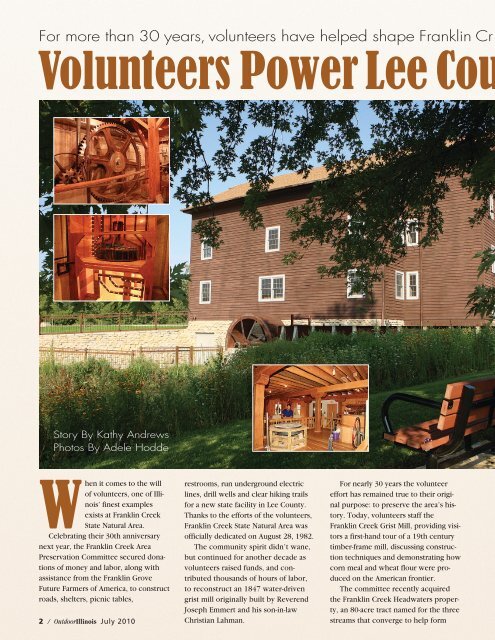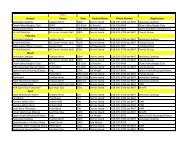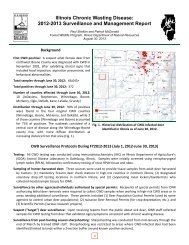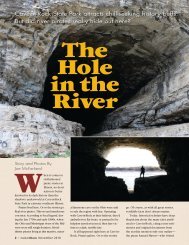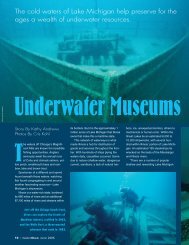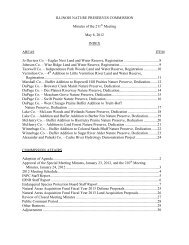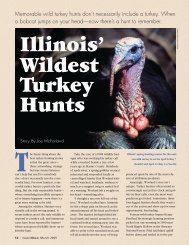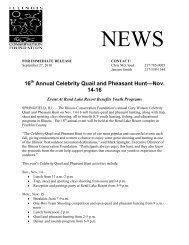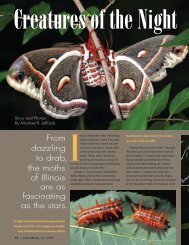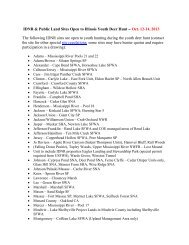Franklin Creek - Illinois DNR
Franklin Creek - Illinois DNR
Franklin Creek - Illinois DNR
Create successful ePaper yourself
Turn your PDF publications into a flip-book with our unique Google optimized e-Paper software.
For more than 30 years, volunteers have helped shape <strong>Franklin</strong> Cr<br />
Volunteers Power Lee Couu<br />
Story By Kathy Andrews<br />
Photos By Adele Hodde<br />
When it comes to the will<br />
of volunteers, one of <strong>Illinois</strong>’<br />
finest examples<br />
exists at <strong>Franklin</strong> <strong>Creek</strong><br />
State Natural Area.<br />
Celebrating their 30th anniversary<br />
next year, the <strong>Franklin</strong> <strong>Creek</strong> Area<br />
Preservation Committee secured donations<br />
of money and labor, along with<br />
assistance from the <strong>Franklin</strong> Grove<br />
Future Farmers of America, to construct<br />
roads, shelters, picnic tables,<br />
2 / Outdoor<strong>Illinois</strong> July 2010<br />
restrooms, run underground electric<br />
lines, drill wells and clear hiking trails<br />
for a new state facility in Lee County.<br />
Thanks to the efforts of the volunteers,<br />
<strong>Franklin</strong> <strong>Creek</strong> State Natural Area was<br />
officially dedicated on August 28, 1982.<br />
The community spirit didn’t wane,<br />
but continued for another decade as<br />
volunteers raised funds, and contributed<br />
thousands of hours of labor,<br />
to reconstruct an 1847 water-driven<br />
grist mill originally built by Reverend<br />
Joseph Emmert and his son-in-law<br />
Christian Lahman.<br />
For nearly 30 years the volunteer<br />
effort has remained true to their original<br />
purpose: to preserve the area’s history.<br />
Today, volunteers staff the<br />
<strong>Franklin</strong> <strong>Creek</strong> Grist Mill, providing visitors<br />
a first-hand tour of a 19th century<br />
timber-frame mill, discussing construction<br />
techniques and demonstrating how<br />
corn meal and wheat flour were produced<br />
on the American frontier.<br />
The committee recently acquired<br />
the <strong>Franklin</strong> <strong>Creek</strong> Headwaters property,<br />
an 80-acre tract named for the three<br />
streams that converge to help form
eek State Natural Area.<br />
ntyPark<br />
(Photo by Elmer Stauffer.)<br />
Volunteers provide guided<br />
tours of the reconstructed<br />
1847 water-driven grist mill<br />
at <strong>Franklin</strong> <strong>Creek</strong> State<br />
Natural Area.<br />
<strong>Franklin</strong> <strong>Creek</strong>. Among the primary<br />
funders were individuals, the local<br />
bank, the <strong>Illinois</strong> Clean Energy Community<br />
Foundation and the John Husar<br />
Memorial fund.<br />
Established in 1999, the <strong>Illinois</strong><br />
Clean Energy Community Foundation<br />
invests in clean energy development<br />
and land preservation efforts, working<br />
with communities and residents to<br />
improve environmental quality in <strong>Illinois</strong>.<br />
Using a $225 million endowment<br />
provided by Commonwealth Edison,<br />
the foundation has funded more than<br />
3,000 grants in three program areas:<br />
improving energy efficiency, developing<br />
renewable energy resources, and<br />
preserving and enhancing natural areas<br />
and wildlife habitat throughout <strong>Illinois</strong>.<br />
To date, Foundation Natural Area grants<br />
have helped to protect more than<br />
14,500 acres throughout the state.<br />
“The headwaters project combines<br />
the best of multiple worlds,” explained<br />
Jolie Krasinski, foundation program<br />
officer. “It is the coming together of<br />
public and private efforts to make<br />
something happen during what has<br />
been a relatively challenging time for<br />
land conservation in the state. The<br />
foundation was, and is, most impressed<br />
by the group’s work to build a public<br />
and privately owned, but publicly<br />
accessible, trail from the town of<br />
<strong>Franklin</strong> Grove to Nachusa Grasslands.<br />
This group sees beyond the boundaries<br />
of their preserve and tries to not only<br />
make it relevant to the local citizens<br />
(though connections with the history<br />
and culture of the area), but of interest<br />
and enjoyment to the larger region by<br />
A historic, stone railroad bridge<br />
spans a stream within the<br />
newly acquired <strong>Franklin</strong> <strong>Creek</strong><br />
Headwaters property.<br />
working to connect <strong>Franklin</strong> <strong>Creek</strong><br />
State Natural Area to another significant<br />
natural area of the state.”<br />
Seeking a quiet retreat from their<br />
busy lives in the Chicago suburbs, and<br />
planning for their retirement years,<br />
John and Louise Husar purchased property<br />
bordered on two sides by <strong>Franklin</strong><br />
<strong>Creek</strong> SNA. John, an award-winning<br />
sportswriter, columnist for the Chicago<br />
Tribune and advocate for wildlife<br />
restoration, hunting and fishing access<br />
in <strong>Illinois</strong>, found much of his inspiration<br />
while at the <strong>Franklin</strong> <strong>Creek</strong> cabin.<br />
After John’s untimely death in<br />
2000, Louise proceeded with the plan<br />
to retire to Lee County, enjoying the<br />
can-do attitude of the local folk and<br />
peacefulness of the park. When the<br />
need arose to<br />
quickly acquire a<br />
critical tract of<br />
land, Louise<br />
offered to loan<br />
the committee<br />
money raised for<br />
a memorial to her<br />
Louise Husar<br />
late husband. The<br />
memorial money was combined with<br />
other resources to make the land purchase<br />
possible.<br />
“I couldn’t think of a more fitting<br />
tribute to John than assisting with the<br />
expansion of the park he considered<br />
<strong>Franklin</strong> <strong>Creek</strong> volunteers include a<br />
local school who enhanced a prairie<br />
restoration area as a part of the Earth<br />
Day in the Parks program. July 2010 Outdoor<strong>Illinois</strong> / 3
Remnant and restored prairies recall<br />
the landscape that attracted pioneering<br />
families settling the <strong>Franklin</strong><br />
<strong>Creek</strong> area in the 1830s.<br />
one of <strong>Illinois</strong>’ hidden gems,” Louise<br />
said. “John was a very spiritual man<br />
and I plan to eventually use the memorial<br />
funds to enhance this park as a<br />
spiritual retreat.”<br />
In addition to commemorating settlement<br />
of the region, preserving the<br />
land known as <strong>Franklin</strong> <strong>Creek</strong> State Natural<br />
Area also recognizes an area with<br />
rich geologic and natural resources.<br />
The same features that drew pioneer<br />
families in the 1830s—large, cool<br />
springs, hardwood forests, a picturesque<br />
creek and deep valleys protected<br />
from winter winds—are what<br />
led to the 1970 designation of 198 acres<br />
as <strong>Illinois</strong>’ 24th nature preserve.<br />
Flowing through the site for thousands<br />
of years, <strong>Franklin</strong> <strong>Creek</strong> has<br />
(Photo by Elmer Stauffer.)<br />
carved a scenic valley and exposed<br />
three distinct rock strata, including<br />
New Richmond sandstone. Dating back<br />
500 million years, this is the oldest<br />
exposed rock formation in <strong>Illinois</strong>, and<br />
is found only at <strong>Franklin</strong> <strong>Creek</strong> and one<br />
other location.<br />
On a hill prairie remnant grow Indian<br />
grass, tall dropseed, false toadflax,<br />
flowering spurge and hoary puccoon.<br />
Canada yew, an evergreen shrub of<br />
more northern woods, grows on an<br />
undisturbed cliff community, along<br />
with bladdernut, bishop’s cap, shooting<br />
star and several species of ferns.<br />
Seeps and springs within the forest<br />
support moist-soil plants such as skunk<br />
Site amenities include volunteer-led<br />
youth bow hunting workshops and<br />
accessible fishing opportunities.<br />
cabbage, wild black currant and<br />
swamp rose.<br />
To experience the scenic beauty of<br />
the linear, 882-acre park, head out on<br />
Pioneer Pass, a 1.85 mile trail that connects<br />
two day use areas located on each<br />
end of the park. Each day-use area has a<br />
loop trail (the popular Mill Springs Trail<br />
is a 1/3-mile concrete-surfaced trail suitable<br />
for people of all mobility levels)<br />
which also connects to Pioneer Pass. A<br />
total of 4.5 miles of marked hiking trails<br />
exist here.<br />
Thanks to the efforts of another partner,<br />
the Rock River Trail and Horseman<br />
Association, an extensive, 12-mile equestrian<br />
trail system was developed, which<br />
riders find interesting for the variety of<br />
terrains and vegetation. After the hunting<br />
season (white-tailed deer and wild<br />
At a glance<br />
<strong>Franklin</strong> <strong>Creek</strong> State Natural<br />
Area, 1872 Twist Road, <strong>Franklin</strong><br />
Grove, IL 61031<br />
Telephone: (815) 456-2878<br />
Web site: dnr.state.il.us/lands/land<br />
mgt/parks/r1/franklin.htm<br />
Directions: <strong>Franklin</strong> <strong>Creek</strong> SNA is<br />
located between Rochelle and Dixon.<br />
Traveling on <strong>Illinois</strong> Route 38, turn<br />
north on Daysville Road, on the west<br />
side of the small town of <strong>Franklin</strong><br />
Grove, and go one block to Old Mill<br />
Road. Turn left (west) on Old Mill Road<br />
and proceed 1 mile to the site.<br />
4 / Outdoor<strong>Illinois</strong> July 2010
The purpose of the Rock River Trail<br />
& Horseman Association, established<br />
in 1940 and <strong>Illinois</strong>’ oldest horse<br />
club, is to promote horsemanship and<br />
horseback riding for pleasure, and stimulate<br />
and maintain interest in riding<br />
horses. For information on upcoming<br />
events, visit http://rrtha.tripod.com/<br />
rrtha.html, e-mail rrthapresident@<br />
gmail.com or call (815) 973-1371 or<br />
(815) 541-9522. Events are at <strong>Franklin</strong><br />
<strong>Creek</strong> State Natural Area unless otherwise<br />
noted.<br />
An extensive equestrian program<br />
exists at <strong>Franklin</strong> <strong>Creek</strong> thanks to the<br />
efforts of the Rock River Trail and<br />
Horseman Association.<br />
turkey), and when conditions permit, a<br />
portion of the trail sees use by snowmobilers<br />
and cross-country skiers. The association<br />
also developed an outdoor show<br />
area and welcomes riders and observers<br />
to their two annual horse shows.<br />
“The June show is a formal event,<br />
with a large crowd of horses and variety<br />
of rider skill levels,” Joyce O’Brien,<br />
association president, said. “Timed<br />
events take place on Saturday, followed<br />
by horsemanship classes on Sunday.”<br />
The September weekend is marketed<br />
as a Fun Show and includes a poker<br />
run and events for the entire family. For<br />
further information on the events, visit<br />
rrtha.tripod.com/rrtha.html.<br />
Tempted by the cool, clear waters<br />
in <strong>Franklin</strong> <strong>Creek</strong>? Fishing is permitted<br />
on state-owned land, so be sure to<br />
pick up a park map to verify that you<br />
are on park property. The map depicts<br />
three ponds, Dysart, Senger and Black<br />
Bass, which actually are wide spots in<br />
the creek made popular by early settler<br />
families. Carry on a tradition dating<br />
back more than 165 years. Gather<br />
your fishing equipment and the family<br />
for a Sunday picnic at one of the<br />
“ponds” and try for a limit of smallmouth<br />
bass, channel catfish, carp, redhorse<br />
and, when stocked, rock bass<br />
that reside in the creek.<br />
The Mill Pond provides a more<br />
accessible fishing spot and supports a<br />
population of largemouth and smallmouth<br />
bass, bluegill, green sunfish and<br />
bullhead.<br />
For a more formal picnic setting,<br />
select one of the five shelters located in<br />
Norwegian Hill and Mill Springs Day<br />
Use Areas, each supplied with electricity,<br />
cooking grills, picnic tables,<br />
restrooms and drinking water. Four of<br />
the shelters may be reserved through<br />
Sept. 18, 2 p.m., Poker Run<br />
Sept. 19, 10 a.m., Fun Show, canter<br />
lope84@yahoo.com or (815)<br />
501-6874<br />
Oct. 9, 10 a.m., St. Jude’s Benefit<br />
Ride & Chili Dump, location TBA<br />
Oct. 10, 2 p.m. St. Jude’s Benefit<br />
Poker Run, location TBA<br />
reserveamerica.com. The parking lot at<br />
Sunday’s Bridge—named for the 1800sera<br />
family residing there—provides<br />
access to four walk-in picnic facilities.<br />
<strong>Franklin</strong> <strong>Creek</strong> SNA is an area rich in<br />
history and bounding with local pride for<br />
the power of volunteers. Plan a visit this<br />
year, and let them show you what the<br />
excitement is all about.<br />
Area attractions<br />
The newly acquired <strong>Franklin</strong> <strong>Creek</strong> Headwaters property straddles <strong>Illinois</strong> Route 38,<br />
providing the opportunity to develop the highly visible site as a model for best-use land<br />
management practices and erect an informational kiosk promoting area attractions. In<br />
addition, creation of a 5.5-mile public access trail is proposed, beginning at the west<br />
edge of <strong>Franklin</strong> Grove, passing through the Headwaters property and connecting to<br />
existing trails at <strong>Franklin</strong> <strong>Creek</strong> SNA and Nachusa Grasslands.<br />
Lincoln Highway<br />
The Lincoln Highway Association was created in 1913 and resulted in a 3,400 mile<br />
coast-to-coast highway which enters <strong>Illinois</strong> at Chicago Heights and exits near Fulton. The<br />
association’s national headquarters is located at <strong>Franklin</strong> Grove in a dry goods store built<br />
in 1860 by Henry Isaac Lincoln. For further information see lincolnhighwayassoc.org.<br />
Chapin <strong>Creek</strong> Historic Village<br />
The <strong>Franklin</strong> Grove Area Historical Society has created Chaplin <strong>Creek</strong> Historic Village,<br />
an evolving prairie settlement typical of the middle 19th century. Among the buildings<br />
are a forge, saltbox house, school house, village jail, an early settler’s cabin and English-style<br />
barn. Several special events occur during the year including the Summer Harvest<br />
Festival. The village is open Saturdays from 10 a.m.-4 p.m. and Sundays noon-4 p.m.<br />
from mid April to mid October. For information call (815) 456-2382 or visit franklin<br />
groveil.org/testt.htm.<br />
Nachusa Grasslands<br />
With more than 3,000 acres of land under protection, Nachusa Grasslands is one of<br />
<strong>Illinois</strong>’ largest prairies. Located 4 miles northwest of <strong>Franklin</strong> Grove on Lowden Road,<br />
the grassland serves as a living model for land management techniques and natural areas<br />
restoration. For further information, contact The Nature Conservancy at (815) 973-0245.<br />
July 2010 Outdoor<strong>Illinois</strong> / 5


